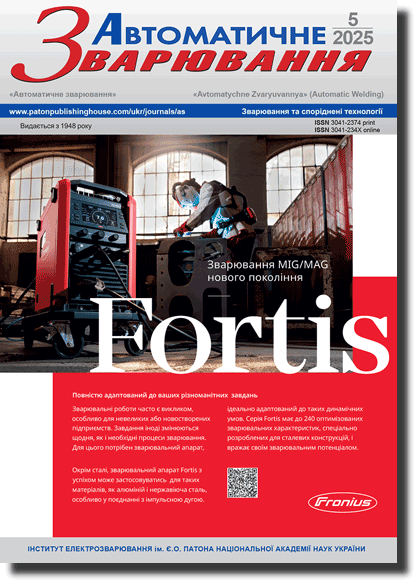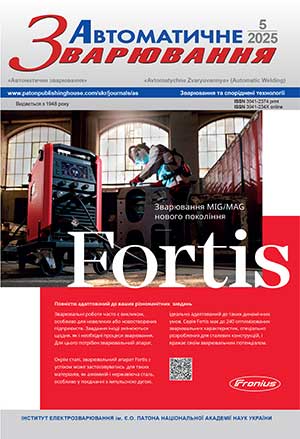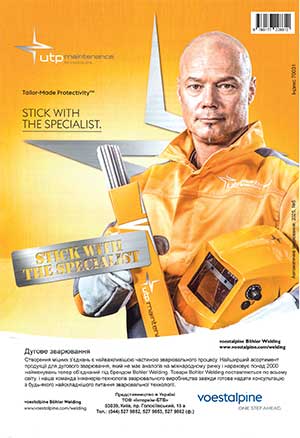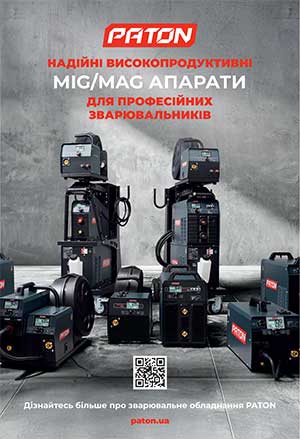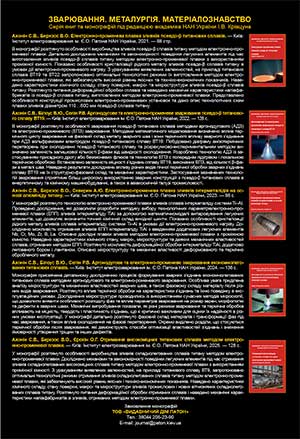| 2025 №05 (02) |
DOI of Article 10.37434/as2025.05.03 |
2025 №05 (04) |
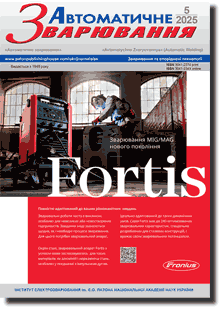
"Avtomatychne Zvaryuvannya" (Automatic Welding), #5, 2024, pp. 25-30
Use of the hough transformation method for the metallographic studies of ferritic-bainitic steels microstructure
V.V. Holovko1, O.O. Shtofel1,2, D.Yu. Korolenko1
1E.O. Paton Electric Welding Institute of the NAS of Ukraine 11 Kazymyr Malevych Str., 03150, Kyiv, Ukraine. E-mail: v_golovko@ukr.net2National Technical University of Ukraine «Igor Sikorsky Kyiv Polytechnic Institute». 37 Beresteysky Ave., 03056, Kyiv, Ukraine. E-mail: o.shtof@gmail.com
High-strength low-alloy steels are a promising material for the manufacture of welded metal structures, but their widespread use is hampered by their increased sensitivity to defects that arise during the welding process. Therefore, a fundamental aspect of developing the technology for welding these steels is understanding how the properties of the metal change during the welding process and identifying the main microstructural characteristics that explain these changes. Research on high-strength ferritic- bainitic steels, which concerns the microstructural characteristics and mechanical properties, is aimed at determining the total angle of structural grains disorientation, using the electron backscatter diffraction (EBSD) method, which can be implemented on electron microscopes, and requires special software installation. The metallographic analysis method using the Hough transformation, which can be implemented on optical microscopes and does not require special software, should be considered as an alternative to the EBSD method. 24 Ref., 5 Fig.
Keywords: high-strength low-alloy steel, welding, microstructure, metallographic analysis, grain boundaries, structural grains disorientation, Hough transformation
Received: 21.02.2025
Received in revised form: 16.07.2025
Accepted: 12.09.2025
References
1. Hall, E.O. (1951) The deformation and ageing of mild steel: III Discussion of results. Proc. Phys. Soc. B, 64(9), 747-753. https://doi.org/10.1088/0370-1301/64/9/3032. Petch, N.J. (1953) The cleavage strength of polycrystals. J. Iron Steel Inst., 174, 25-28.
3. Chapetti, M., Miyata, H., Tagawa, T. et al. (2004) Fatigue strength of ultra-fine grained steels. Mater. Sci. Eng. A, 381, 331-336. https://doi.org/10.1016/j.msea.2004.04.055
4. Hansen, N. (2004) Hall-Petch relation and boundary strengthening. Scr. Mater., 51, 801-806. https://doi.org/10.1016/j.scriptamat.2004.06.002
5. Yang, X.L., Xu, Y.B., Tan, X.D., Wu, D. (2014) Influences of crystallography and delamination on anisotropy of Charpy impact toughness in API X100 pipeline steel. Mater. Sci. Eng. A, 607, 53-62. https://doi.org/10.1016/j.msea.2014.03.121
6. Joo, M.S., Suh, D.-W., Bae, J.H., Bhadeshia, H.K.D.H. (2012) Toughness anisotropy in X70 and X80 pipeline steels. Mater. Sci. Eng. A, 556, 601-606. https://doi.org/10.1179/1743284713Y.0000000371
7. Jabr, H.M.A., Speer, J.G., Matlock, D.K. et al. (2013) Anisotropy of mechanical properties of API X70 spiral welded pipe steels. Mater. Sci. Forum, 753, 538-541. https://doi.org/10.4028/www.scientific.net/MSF.753.538
8. Sanchez, N., Petrov, R., Bae, J.H., Kim, K. (2010) Texture dependent mechanical anisotropy of X80 pipeline steel. Adv. Eng. Mater., 12, 973-980. https://doi.org/10.1002/adem.201000065
9. Cheng, S., Zhang, X., Zhang, J. et al. (2016) Effect of start cooling temperature on microstructure and properties of X80 pipeline steel. Mater. Sci. Eng. A, 666, 156-164. https://doi.org/10.1016/j.msea.2016.04.066
10. Herbig, M., Raabe, D., Li, Y.J. et al. (2014) Atomic-scale quantification of grain boundary segregation in nanocrystalline material. Physical Review Letters, 112, 126103. https://doi.org/10.1103/PhysRevLett.112.126103
11. Duan, Q., Yan, J., Zhu, G.H., Cai, Q.W. (2013) Effects of grain size and misorientation on anisotropy of X80 pipeline steel. Hot Working Tech., 24, 107-109. https://caod.oriprobe.com/articles/41006381/Effects_of_Grain_Size_and_Misorientation_on_Anisot.htm
12. Masoumi, M., Silva, C.C., Abreu, H.F.G.D. (2018) Effect of rolling in the recrystallization temperature region associated with a post-heat treatment on the microstructure, crystal orientation, and mechanical properties of API 5L X70 pipeline steel. J. Mater. Eng. Perfor., 27, 1694-1705. https://doi.org/10.1590/1980-5373-mr-2016-0651
13. Deng, C.M., Li, Z.D., Sun, X.J., Yong, Q.L. (2014) Influence mechanism of high angle boundary on propagation of cleavage cracks in low martensite steel. Mater. Mech. Eng., 38, 20-24.
14. Shen, J.C., Luo, Z.J., Yang, C.F., Zhang, Y.Q. (2014) «Effective grain size» affecting low temperature toughness in lath structure of HSLA steel. J. Iron Steel Res. Int., 26(7), 70-76.
15. Hussein, A., Kim, B., Verbeken, K., Depover, T. (2024) The effect of grain boundary misorientation on hydrogen flux using a phase-field based diffusion and trapping model. Advanced Engineering Materials, 26(22), 2401561. https://doi.org/10.1002/adem.202401561
16. Raabe, D., Herbig, M., Sandlöbes, S. et al. (2014) Grain boundary segregation engineering in metallic alloys: A pathway to the design of interfaces. Current Opinion in Solid State and Materials Science, 18, 253-261. https://doi.org/10.1016/j.cossms.2014.06.002
17. Stojanovic, N., Glisovic, J., Abdullah, O.I. et al. (2022) Particle formation due to brake wear, influence on the people health and measures for their reduction: a review. Environ Sci. Pollut Res., 29, 9606-9625. https://doi.org/10.1007/s11356-021-17907-3
18. Vincentis, N.S., Roatta, A., Bolmaro, R.E., Signorelli, J.W. (2019) EBSD analysis of orientation gradients developed near grain boundaries. Materials Research, 22(1), e20180412. https://doi.org/10.1590/1980-5373-mr-2018-0412
19. Pauli, L., Heikki, R. (2022) EBSD characterisation of grain size distribution and grain sub-structures for ferritic steel weld metals. Welding in the World, 66, 363-377. https://doi.org/10.1007/s40194-021-01225-w
20. Hwang, B., Kim, Y.G., Lee, S. et al. (2005) Effective grain size and charpy impact properties of high-toughness X70 pipeline steels. Metallurgical and Materials Transactions A, 36, 2107-2114. https://doi.org/10.1007/s11661-005-0331-9
21. Stojanovic, N., Belhocine, A., Abdullah, O.I., Grujic, I. (2023) The influence of the brake pad construction on noise formation, people's health and reduction measures. Environ Sci. Pollut Res., 30, 15352-15363. https://doi.org/10.1007/s11356-022-23291-3
22. Li, X.C., Zhao, J.X., Cong, J.H. et al. (2021) Machine learning guided automatic recognition of crystal boundaries in bainitic/martensitic alloy and relationship between boundary types and ductile-to-brittle transition behavior. J. Mater. Sci. Technol., 84, 49-58. https://doi.org/10.1016/j.jmst.2020.12.024
23. Atiquzzaman, M. (1992) Multiresolution hough transform-an efficient method of detecting patterns in images. IEEE Trans. on Pattern Analysis and Machine Intelligence, 14(11), 1090-1095. https://doi.org/10.1109/34.166623
24. Zhuravel, I.M., Maksymovych, V.M. (2018) Quantitative analysis of orientation and elongation of grains on metallographic images using Hough transformations. Naukovyi visnyk NLTU Ukrainy, 28(5), 135-139 [in Ukrainian]. https://doi.org/10.15421/40280528
Advertising in this issue:
To order the electronic version of the paper:
V.V. Holovko, O.O. Shtofel, D.Yu. KorolenkoUse of the hough transformation method for the metallographic studies of ferritic-bainitic steels microstructure
Automatic Welding №05 2025 p.25-30
The cost of article (pdf): 13 $, 12 €, 150 UAH (1 copy. )
fill in the form below:
The cost of subscription/purchase order journals or individual articles
| Journal/Currency | Annual Set | 1 issue printed |
1 issue |
one article |
| TPWJ/USD | 384 $ | 32 $ | 26 $ | 13 $ |
| TPWJ/EUR | 348 € | 29 € | 24 € | 12 € |
| TPWJ/UAH | 7200 UAH | 600 UAH | 600 UAH | 280 UAH |
| AS/UAH | 1800 UAH | 300 UAH | 300 UAH | 150 UAH |
| AS/USD | 192 $ | 32 $ | 26 $ | 13 $ |
| AS/EUR | 180 € | 30 € | 25 € | 12 € |
| SEM/UAH | 1200 UAH | 300 UAH | 300 UAH | 150 UAH |
| SEM/USD | 128 $ | 32 $ | 26 $ | 13 $ |
| SEM/EUR | 120 € | 30 € | 25 € | 12 € |
| TDNK/UAH | 1200 UAH | 300 UAH | 300 UAH | 150 UAH |
| TDNK/USD | 128 $ | 32 $ | 26 $ | 13 $ |
| TDNK/EUR | 120 € | 30 € | 25 € | 15 € |
AS = «Automatic Welding» - 6 issues per year;
TPWJ = «PATON WELDING JOURNAL» - 12 issues per year;
SEM = «Electrometallurgy Today» - 4 issues per year;
TDNK = «Technical Diagnostics and Non-Destructive Testing» - 4 issues per year.





